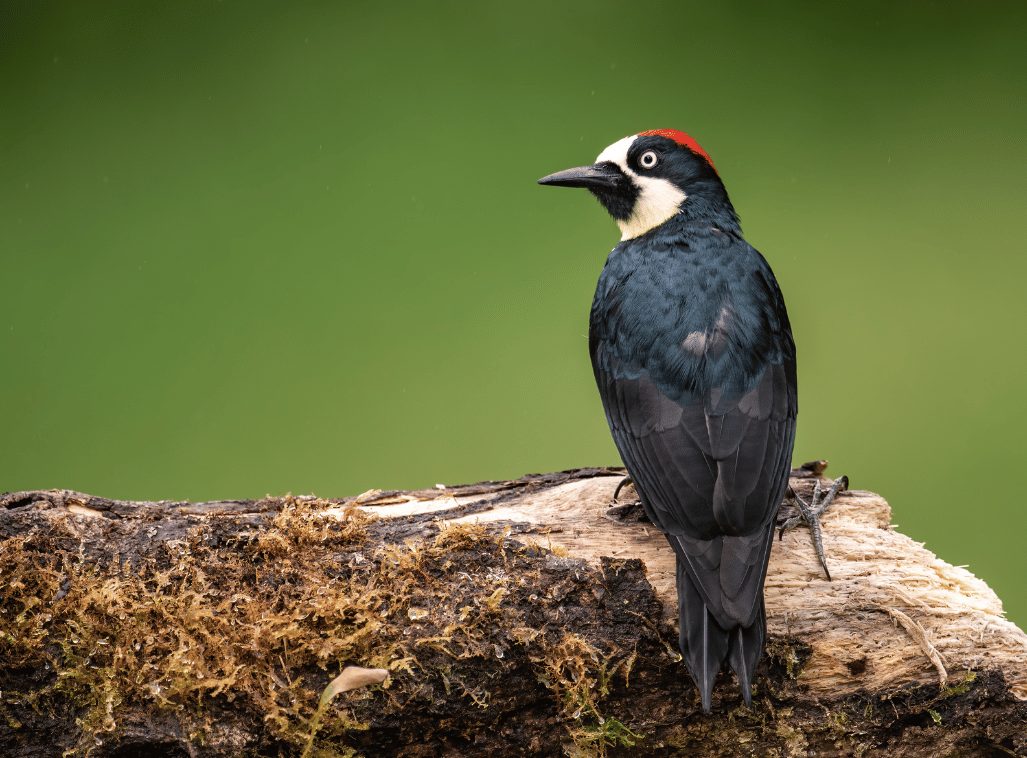Introduction
Acorn Woodpeckers are a fascinating and charismatic species found in oak woodlands and mixed forests of the western United States, including California. Known for their unique behavior of storing acorns and their vibrant plumage, these birds play a vital role in their ecosystems.
Description
Acorn Woodpeckers are medium-sized woodpeckers with a distinctive appearance. They have a striking black and white face pattern, a bright red cap, and white eyes. Their bodies are mostly black with white underparts and a white rump visible in flight. Both males and females look similar, although males typically have a larger red cap.
Fun Facts
- Granary Trees: Acorn Woodpeckers are known for their communal storage system. They drill holes in trees, telephone poles, and even wooden structures to store acorns. Some granary trees can have thousands of acorns.
- Social Structure: These woodpeckers live in cooperative breeding groups, where multiple males and females share nesting and feeding duties. This social structure is unusual among birds and contributes to their complex social behaviors.
- Voice: Acorn Woodpeckers have a unique and varied vocal repertoire. Their calls include a distinctive “waka-waka-waka” sound, which helps them communicate within their groups.
- Memory Masters: They have excellent memories, which they use to recall the locations of the acorns they have stored. This ability is crucial for their survival, especially during winter months when food is scarce.
- Color Vision: Like many birds, Acorn Woodpeckers have excellent color vision, which helps them locate and distinguish between different types of food.
Behavior
These woodpeckers are highly social and live in cooperative breeding groups. They are best known for their “granary trees,” where they create numerous holes to store acorns. These granaries can contain thousands of acorns and are used by the group throughout the winter when food is scarce.
Diet
As their name suggests, acorns make up a significant portion of their diet. However, Acorn Woodpeckers also feed on insects, fruits, seeds, and sap. They catch insects in flight and forage for other food items on trees and the ground.
Habitat
Acorn Woodpeckers are commonly found in oak woodlands, mixed forests, and suburban areas with large oak trees. They prefer habitats where they can find suitable trees for storing their acorns.
Reproduction
Breeding typically occurs in spring and early summer. The cooperative breeding groups, which may include several breeding pairs, share responsibilities for raising the young. Nests are usually excavated in dead trees or dead parts of live trees. Both males and females incubate the eggs and feed the chicks.
Conservation
Acorn Woodpeckers are currently not considered threatened, and their populations are stable. However, habitat loss due to urban development and changes in forest management practices could impact their numbers in the future. Conservation efforts focus on preserving oak woodlands and ensuring the availability of suitable nesting and granary trees.
How to Attract Acorn Woodpeckers to Your Property
- Provide Oak Trees: Plant and maintain oak trees on your property, as they are the primary source of acorns for these woodpeckers.
- Create Nesting Sites: Install nest boxes designed for woodpeckers or leave dead trees and branches standing to provide natural nesting sites.
- Avoid Pesticides: Reduce or eliminate the use of pesticides to ensure a healthy insect population for the woodpeckers to feed on.
- Provide Water: Set up a birdbath or a small water feature to attract Acorn Woodpeckers and other wildlife.
- Plant Native Shrubs: Include native shrubs and trees in your landscaping to provide additional food sources and shelter.
Conclusion
Acorn Woodpeckers are a unique and vital part of the ecosystems they inhabit. By understanding their behavior and needs, we can help support their populations and enjoy the benefits of having these fascinating birds in our local environments.


